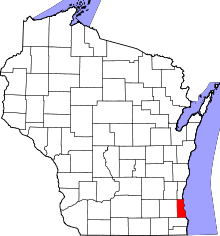Milwaukee Metropolitan Sewerage District

The Milwaukee Metropolitan Sewerage District (MMSD) is a state-chartered government agency which provides wastewater services for 28 municipalities within Milwaukee County and also portions of the surrounding counties. It treats, and also releases, the largest amount of water pollution of any agency or company in the State of Wisconsin.[1][2]
With headquarters and a central laboratory along the Menomonee River near downtown Milwaukee, it has two wastewater treatment plants which are located at Jones Island (43°01′23.5″N 87°53′58″W / 43.023194°N 87.89944°W) in Milwaukee and at the South Shore (42°53′16″N 87°50′44″W / 42.88778°N 87.84556°W) in Oak Creek. These facilities were operated by United Water under a 10-year agreement ending March 1, 2008. Veolia Water is the current operator.
"The world’s first large scale wastewater treatment plant was constructed on Jones Island, near the shore of Lake Michigan." [3] The primary wastewater treatment plant at Jones Island was one of the first of its kind when the original activated sludge plant was constructed in 1925. MMSD was the first to market biosolids created through this process as a fertilizer under the name "Milorganite."[4][5] The Jones Island Plant was among the first sewage treatment plants in the United States to succeed in using the activated sludge treatment process. "It was the first treatment facility to economically dispose of the recovered sludge by producing an organic fertilizer." In the early 1980s the plant needed extensive reworking, "this does not detract from its historic significance as a pioneering facility in the field of pollution control technology."[5] It had the largest capacity of any plant in the world when constructed.[4][6] The 1925 plant has been designated as a Historic Civil Engineering Landmark by the American Society of Civil Engineers.[5][7][8]
Criticisms of Combined Sewer System
MMSD operates the only combined sewage system in Wisconsin on Lake Michigan.[9] This leads to its dumping of untreated sewage into Lake Michigan by accident or as a result of sewer overflow on a periodic basis.[10] MMSD cannot calculate the exact volume of these dumping events, and therefore can only provide estimates.[9] It has discovered that the estimates MMSD provides have been inaccurate in the past.[9]
The State of Wisconsin filed a complaint against MMSD's dumping in October, 2005.[9] By late March, 2006 the Milwaukee Metropolitan Sewerage District had accidentally dumped 800,000 gallons of sewage into Lake Michigan. The accidents occurred as workers at the Jones Island facility were testing a new computer operating system. Testing was done under the United Water contract. 1994 through mid-2011 MMSD dumped 24.2 billion gallons of untreated sewage including human feces into Lake Michigan.[11] In June 2011, combined sewers discharged 170.5 million gallons of untreated wastewater to rivers and Lake Michigan.
On April 10, 2013 combined sanitary and storm sewer overflows were again redirected to rivers and Lake Michigan.[12] Diverting combined sewer overflows to waterways is an emergency measure to prevent sewage backups into basements.[13] Officials said the heavy rains caused sewers in the Milwaukee area to spill an estimated 595 million gallons of untreated wastewater to local waterways.[14]
On April 18, 2013 MMSD again initiated a combined sewer overflow per Bill Graffin of MMSD. The overflow included both untreated wastewater and stormwater. Wisconsin DNR estimated the overflow to be 5% untreated sewage.[15]
MMSD's combined sewer overflows are smaller than those of other cities on the Great Lakes, including Cleveland's and Detroit's, and are similar to that of the smaller city of Grand Rapids.[2][16] Year-to-year combined sewer overflows vary depending on local rainfall but as a recent example in 2014 MMSD combined sewer overflows totaled 342 million gallons, meaning that 99.5% of the total flow through the municipal sewer system was treated.[17]
See also
References
- ↑ "Report to Congress: Combined Sewer Overflows to the Lake Michigan Basin, EPA-833-R-07-007" (PDF). Washington, DC 20460: Environmental Protection Agency. September 2007. Retrieved April 2, 2014.
- 1 2 Dan Egan (November 30, 2006). "Milwaukee's not the worst — or best — lake polluter". Milwaukee Journal Sentinel.
- ↑ Stephens, Odin L.; Mengak, Michael T.; Osborn, David; Miller, Karl V. (March 2005). "Using Milorganite to temporarily repel white-tailed deer from food plots" (PDF). Wildlife Management Series. WSFR.
- 1 2 Program Management Office, Milwaukee Water Pollution Abatement Program; CH2M HILL, INC.; Donohue & Associates, Inc.; Howard Needles Tammen & Bergendoff; Graef, Anhalt, Schloemer and Associates, Inc.; Poly tech, Inc.; J.C. Zimmerman Engineering Corp.; Camp Dresser & McKee, Inc. (April 1982). Historic Documentation of the Jones Island West Plant (PDF). Milwaukee Water Pollution · Abatement Program. Milwaukee, Wisconsin: Milwaukee Metropolitan Sewerage District. Retrieved August 8, 2015.
- 1 2 3 Merritt, Raymond H. (1982). Historical Report Photographs, Written Historical and Descriptive Data (PDF). Historic American Engineering Record. National Park Service. Retrieved April 1, 2014.
- ↑ Freese, Simon W., P.E.; Sizemore, Deborah Lightfoot. A Century in the Works: 100 Years of Progress in Civil and Environmental Engineering; Freese and Nichols Consulting Engineers 1894-1994 (PDF). p. 44. Retrieved April 2, 2014.
- ↑ American Society of Civil Engineers (August 13, 1974). "Regarding designation of the Jones Island plant as a national engineering landmark" (Press release).
- ↑ "Environmental Draft Impact Statement: Milwaukee Metropolitan Sewage District; Water Pollution Abatement Program, No. E1S801072DB". Environmental Protection Agency. November 1980. p. V-100. Retrieved April 1, 2014.
- 1 2 3 4 http://www.epa.gov/npdes/pubs/cso_reporttocongress_lakemichigan.pdf
- ↑ "Milwaukee Metropolitan Sewerage District - HOME PAGE-(MMSD) Milwaukee Metropolitan Sewerage District". mmsd.com.
- ↑ "Rep. Jim Sensenbrenner says the Milwaukee Metropolitan Sewerage District is one of the worst polluters in the country". @politifact.
- ↑ Don Behm. "Rain leaves rivers cresting in southeastern Wisconsin; heavy snow hitting north", Milwaukee Journal Sentinel, April 10, 2013.
- ↑ Don Behm (April 11, 2013). "Flood warnings issued for Milwaukee River, other waterways". Milwaukee Journal Sentinel.
- ↑ Milwaukee sewers spilled 595M wastewater gallons
- ↑ MMSD releases sewage from combined system because of flooding
- ↑ http://www.ecojustice.ca/publications/reports/the-great-lakes-sewage-report-card/attachment
- ↑ Don Behm (January 5, 2015). "MMSD treated wastewater reaches nearly 100% in 2014". Milwaukee Journal Sentinel.
